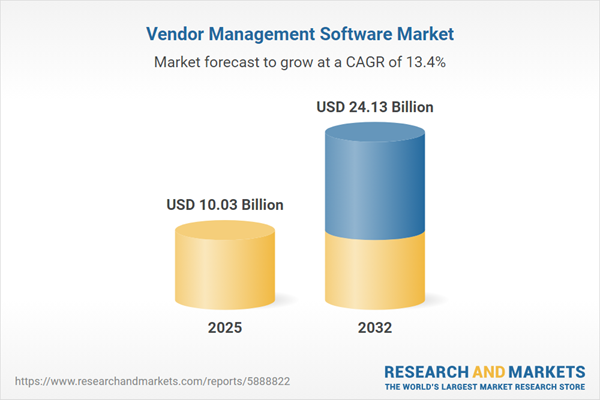Speak directly to the analyst to clarify any post sales queries you may have.
Vendor management software is rapidly transforming procurement, offering C-suite leaders new capabilities to enhance supplier transparency, ensure operational compliance, and adapt to the complexities of modern supply chains. As organizations pursue greater supplier oversight and risk mitigation, these digital solutions serve as pivotal tools in advancing secure, efficient procurement strategies.
Market Snapshot: Vendor Management Software Market
The global vendor management software market continues to demonstrate robust expansion, with a total value of USD 8.83 billion in 2024 and anticipated growth to USD 10.03 billion by 2025, marking a compound annual growth rate of 13.37%. By 2032, estimates position the sector at USD 24.13 billion.
This sustained performance highlights the increasing reliance on digital procurement platforms to unify compliance management, strengthen supplier engagement, and drive data-informed strategies. Strong adoption rates are especially evident among organizations managing international supplier networks and navigating shifting regulatory landscapes, emphasizing the demand for configurable, innovative software tailored to specific market needs and global operations.Scope & Segmentation of the Vendor Management Software Market
This report enables procurement leaders to align technology adoption with organizational transformation. The vendor management software market is classified by functions and features that address a range of operational challenges, offering targeted solutions for diverse enterprise scenarios:
- Component Offerings: Advisory services, tailored software deployment, integration services, staff training, analytics capabilities, contract and invoice management, automated risk assessment, and supplier lifecycle management, each designed to reinforce process resilience.
- Deployment Modes: Cloud-hosted, hybrid, or on-premises configurations are available, allowing firms to optimize infrastructure for regulatory fit and IT governance.
- Organization Size: Solutions are structured to meet enterprise-wide demands for lifecycle visibility, while also offering agility and scalable features for mid-sized businesses undergoing rapid procurement transformation.
- Industry Verticals: Sectors like financial services, insurance, healthcare, IT, telecom, manufacturing, retail, and ecommerce benefit from platforms that enforce compliance, mitigate sector-specific risk, and streamline supply chain management.
- End-User Functions: Procurement, finance, IT, and risk management teams use intuitive dashboards and governance tools to enhance supplier onboarding, monitoring, and performance reporting.
- Geographic Coverage: The market encompasses the Americas, Europe, Middle East and Africa, and Asia-Pacific, addressing diverse regulatory practices, technology standards, and procurement models unique to each region.
Key Takeaways: Strategic Insights for Senior Decision-Makers
- Centralized vendor management software enables streamlined oversight, delivering transparency and standardized governance for improved compliance at each supplier relationship stage.
- Integrated analytics and data visualization support early risk identification and scenario planning, equipping procurement teams to adjust strategies as new risk factors emerge.
- Platforms featuring environmental, social, and governance monitoring tools position organizations to meet sustainability expectations while reducing operational risk.
- User-centric, intuitive interfaces accelerate staff training and support continuous process optimization throughout decentralized procurement functions.
- Data harmonization enhances collaboration between procurement, finance, and risk teams, ensuring thorough evaluation and accountability in supplier selection.
Tariff Impact: Navigating United States 2025 Policy Shifts
The upcoming changes to United States tariff regulations, slated for 2025, drive a renewed commitment to compliance and operational flexibility. Vendor management software equips enterprises with automated classification and real-time monitoring to support fast adaptations to tariff modifications, streamlining policy adherence and continuity in supplier management amid evolving regulatory pressures.
Methodology & Data Sources
This analysis is rooted in direct, structured interviews with procurement, IT, and risk executives. Additional context is supplied through methodical reviews of independent market studies. All findings are validated for accuracy, and participant confidentiality is rigorously maintained throughout the process.
Vendor Management Software: Why This Report Matters
- Presents a structured evaluation framework, enabling senior decision-makers to select vendor management software that aligns with operational and compliance needs amid regulatory change.
- Fosters enterprise achievement of environmental, social, governance, and risk objectives, supporting sustainable growth in procurement operations and supplier management.
- Guides organizations towards integrated, cross-functional procurement processes, driving increased efficiency and transparency across internal teams.
Conclusion
This report delivers actionable guidance, empowering senior leadership to synchronize procurement strategies with business goals and respond effectively to dynamic market requirements and regulatory change.
Additional Product Information:
- Purchase of this report includes 1 year online access with quarterly updates.
- This report can be updated on request. Please contact our Customer Experience team using the Ask a Question widget on our website.
Table of Contents
3. Executive Summary
4. Market Overview
7. Cumulative Impact of Artificial Intelligence 2025
Companies Mentioned
The companies profiled in this Vendor Management Software market report include:- Coupa Software Incorporated
- SAP SE
- Oracle Corporation
- JAGGAER, Inc.
- GEP Worldwide Inc.
- Ivalua SAS
- Zycus Inc.
- International Business Machines Corporation
- Tradeshift Inc.
- Corcentric Inc.
Table Information
| Report Attribute | Details |
|---|---|
| No. of Pages | 183 |
| Published | November 2025 |
| Forecast Period | 2025 - 2032 |
| Estimated Market Value ( USD | $ 10.03 Billion |
| Forecasted Market Value ( USD | $ 24.13 Billion |
| Compound Annual Growth Rate | 13.3% |
| Regions Covered | Global |
| No. of Companies Mentioned | 11 |









